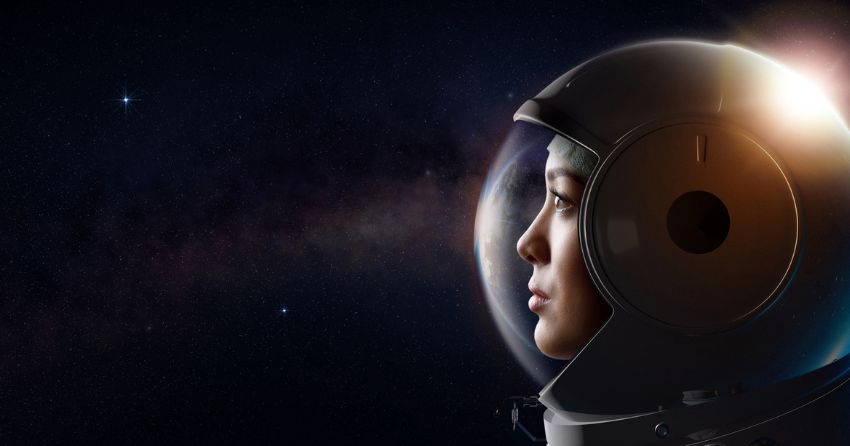Lost In Space: Bones Age Faster in Space—Can NMN Help?

While significant technological and engineering progress has been made in space travel, we’re learning that venturing through the astral plane takes quite a toll on the human body. The onslaught of radiation and the lack of gravity has been shown to affect an astronaut’s health and aging.
An international team of researchers now shows that space travel makes the bones of astronauts age faster. Specifically, microgravity—which causes weightlessness—induces irreversible damage to bone strength, density, and microarchitecture. While bone partially recovers after spaceflight, astronauts can come back with what seems like a decade of earth-bound age-related bone loss in just a matter of months. The study shows that differences in an astronaut’s bone response to microgravity and recovery after return to Earth are primarily explained by mission duration.
“This may not sound like much, but it corresponds to age-related bone loss of at least a decade,” explains study author Dr. Anna-Maria Liphardt. “For those affected, this means they will have to expect a much earlier onset of osteoporosis and susceptibility for fractures.”
This research resulted from an international collaboration between The University of Calgary, NASA Lyndon B. Johnson Space Center, German Centre for Immune Therapy, Friedrich-Alexander-Universität Erlangen-Nürnberg, and Universitätsklinikum Erlangen.
Space Affects Skeletal Strength
The detrimental effect of spaceflight on bone can be profound, causing substantial deterioration of bone tissue density, strength, and microarchitecture. So, determining the extent of bone recovery after prolonged spaceflight is vital for understanding risks to astronauts' long-term skeletal health. “If human beings are in space for three years at a time, we need to keep an eye on the health risks involved as well,” says Liphardt. “This already applies today for missions where astronauts are subject to zero-gravity conditions for usually no longer than six months.”
The research team examined the bone strength, density, and microarchitecture in seventeen astronauts (averaging 47 years of age) before spaceflight, upon returning to Earth, and after 6- and 12-month recovery. Twelve months after flight, the group average for tibia bone strength, bone mineral density, and bone volume all significantly decreased. And the longer the mission, the greater the effect on the recovery. For example, astronauts on longer missions (> 6 months) had even poorer bone recovery. Altogether, nine of 17 astronauts did not fully recover the tibia's total bone mineral density after 12 months. There was also a link between healing and bone cell turnover. Astronauts with incomplete recovery had higher bone turnover biomarkers than astronauts whose bone recovered.
The study suggests that the incomplete recovery of bone strength, density, and trabecular microarchitecture at the weight-bearing tibia, is commensurate with a decade or more of terrestrial age-related bone loss. “We were able to demonstrate that regeneration is more difficult the longer the astronauts were in space,” says Liphardt. “Bone turnover is the process by which cells are broken down, and new ones form,” explains Liphardt. “People with higher activity levels have a higher bone turnover, and the challenge is to keep up these activity levels during missions in space.”

Anti-Aging Measures In Space
Unless countermeasures improve, incomplete bone structure and strength recovery may worsen as missions get longer. “Developing new sports equipment that works in zero-gravity conditions and does not take up much space is particularly challenging. NASA already uses bisphosphonates, but we do not yet know enough about exactly how they work in microgravity.”
Future work is needed to clarify the temporality of bone loss in space and to optimize countermeasures for mitigating bone loss on long-duration flights. “We recommend conducting further systematic research into the combination of medical therapy and physical exercise,” says Liphardt. Until then, elevated biomarkers of bone turnover appear to identify astronauts at the greatest risk of irreversible bone loss; thus, these individuals may benefit most from enhanced preventative measures.
E = (NMN)C2
Previous research has shown that the immediate precursor to nicotinamide adenine dinucleotide (NAD+), nicotinamide mononucleotide (NMN), restores bone tissue health in rodents like mice and rats. Research has shown that NMN can play a role in supporting the health of bone stem cells in older humans. In humans, NMN is necessary for bone stem cells to mature into bone-producing cells called osteoblasts. Enhancing NMN synthesis boosts bone stem cell maturation, produces more osteoblasts, and promotes bone formation, whereas blocking NMN synthesis impairs bone fracture repair in mice by inhibiting the development of bone stem cells into bone-producing cells.
Liu and colleagues from Tianjin Medical University have shown that NMN rejuvenates the regulation of gene activity in bone marrow stem cells from old patients. This confluence of data may push someone to take the plunge into looking at the therapeutic potential of NMN in bone regeneration in astronauts.





